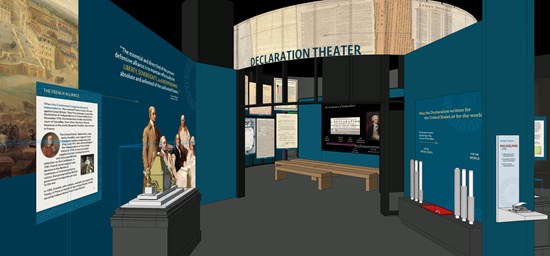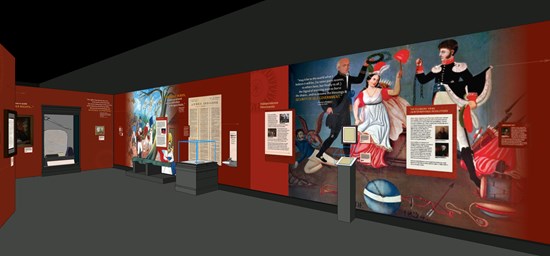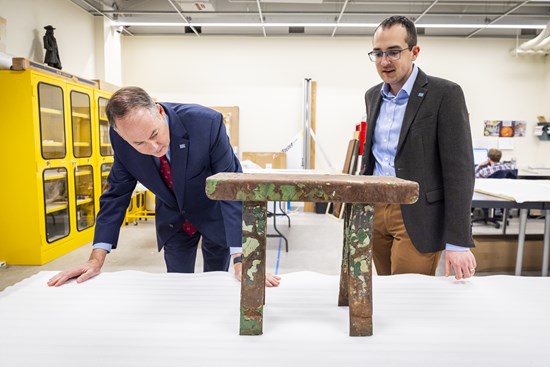More Than 120 Artifacts and Documents From Several Nations and the United States, Presented in an Immersive Gallery Experience, Will Celebrate the American Declaration of Independence's History and Legacy
Presenting Sponsorship From Griffin Catalyst, Additional Support From the City of Philadelphia, Also Announced
Philadelphia, Pennsylvania--(Newsfile Corp. - August 19, 2025) - What does the adoption of the American Declaration of Independence in 1776 have to do with the subsequent 250 years of political and social change? Through the Museum of the American Revolution's most ambitious undertaking since its opening in 2017, visitors will delve into the narratives of nearly 20 countries whose independence movements were inspired by the words of our nation's founding document, as well as stories of how Americans applied and grappled with these ideals from the 18th century through to today.

This rendering of the first section of the exhibition shows the entrance to a circular theater that will include a dynamic 3-4 minute video presentation about the global impact of the Declaration of Independence.
Credit: Courtesy of Roger Westerman Design LLC
To view an enhanced version of this graphic, please visit:
https://images.newsfilecorp.com/files/11838/262944_d29e8214a401f9d3_002full.jpg
The Declaration's Journey, a special exhibition running from Oct. 18, 2025 through Jan. 3, 2027 will be a cornerstone of Philadelphia's cultural offerings for 2026, and will bring more than 120 artifacts from 50 private and institutional lenders together for visitors to experience and understand the Declaration's ongoing relevance and impact on the world. Several artifacts will be on display to the public for the first time, or are returning to the United States for the first time since the Revolutionary era. The nearly 20 nations whose stories will be represented are just a selection of the more than 100 that have integrated the Declaration's ideals in their own movements, proving it to be one of the most influential political documents in modern history.
"The Museum of the American Revolution [has] sought out objects that represent the document's enduring power, complexity, and unfilled promise." - Philadelphia Inquirer
Using objects, documents, and works of art, as well as audio, video, and tactile elements, The Declaration's Journey will examine how national and international leaders like Frederick Douglass, Martin Luther King Jr., Abraham Lincoln, Elizabeth Cady Stanton, Vicente Guerrero, the Marquis de Lafayette, Eleanor Roosevelt, Mahatma Gandhi, Harvey Milk, and many more have used the Declaration's words to inspire hundreds of political revolutions and civil rights movements from the 18th century through to today. This influential document became a model for people who wanted to change the world - and their interpretations, implementations, and adaptation of it also prompted Americans to change their perception of its meaning over time.
These parallel paths of the Declaration's journey - and how it is an ongoing story that we are all a part of today - will be explained throughout the exhibition, and illuminated through a central media theater experience that is the Museum's most robust audio-visual offering ever provided within its 5,000-square-foot special exhibition gallery. This exhibition encompasses the Museum's most ambitious project in its eight-year existence, and folds aspects of history relevant to Americans from all backgrounds and international visitors from Europe, Asia, and Central and South America into the narrative and the impending celebration of our nation's 250th birthday.
"We are all a part of the American story," said Dr. R. Scott Stephenson, President and CEO of the Museum of the American Revolution. "As Philadelphia prepares to welcome the world in 2026 through exciting athletic, history, and cultural events, the Museum of the American Revolution through The Declaration's Journey will provide an experience that will resonate with anyone who walks through our doors."

The second section of the exhibition, as shown in this rendering, focuses on the "Age of Revolutions" in Europe and the Americas.
Credit: Courtesy of Roger Westerman Design LLC
To view an enhanced version of this graphic, please visit:
https://images.newsfilecorp.com/files/11838/262944_d29e8214a401f9d3_003full.jpg
Key Artifacts on Display:
- Thomas Jefferson's Windsor chair, which he is believed to have used while in Philadelphia working on the draft of the Declaration of Independence, will be on display courtesy of the American Philosophical Society alongside the steel prison bench King sat on in April 1963 while drafting his famous "Letter from a Birmingham Jail," on loan from the Birmingham Civil Rights Institute.
- Elizabeth Cady Stanton's desk, likely used during the writing process for History of Woman Suffrage and on loan from Stanton's great-great-granddaughter Coline Jenkins, will be displayed alongside an 1848 printing of the Declaration of Sentiments, on loan from the Historical Society of Pennsylvania.
- A spinning wheel presented by Mahatma Gandhi during India's independence movement, on loan from Ila Jasani Good.
- Military clothing worn by Mexican Revolutionaries Vincente Guerrero, José María Morelos y Pavón, and Mariano Matamoros y Guridi, as well as a military drum, on loan from the Museo Nacional de Historia in Mexico.
- A traveling trunk owned by pathbreaking Korean immigrant Philip Jaisohn, who organized the First Korean Congress in Philadelphia during the March First Movement, the effort for Korean independence in 1919. The trunk will be on loan from the Jaisohn Memorial House in Media, Pennsylvania.
- A bronze cannon on loan from Fort Ticonderoga that was cast in France, transported to the Caribbean colony of Saint Domingue, and positioned on a plantation near Fort-Liberté, likely seeing action during the Haitian Revolution. It will be on display alongside a manuscript copy of the Haitian Declaration, on loan from the David M. Rubenstein Rare Book & Manuscript Library at Duke University.
- A stone salvaged from the Bastille with three portraits of King Louis XVI, the Marquis de Lafayette, and Jean Sylvain Bailly, later engraved on it, along with the Latin inscription, "liberty comes from unity," on loan from the Musée de l'Armée in Paris.
- A copy of the Declaration of Independence of the Czechoslovak Nation issued Oct. 18, 1918, and sent to President Woodrow Wilson by the provisional Czechoslovak government, on loan from the Library of Congress.
- A copy of the Treaty of Watertown, which was signed by ten Mi'kmaw and Wolastoqiyik (also called Maliseet) tribal representatives and became the first international treaty to refer to the independent United States, on loan from the Beinecke Rare Book and Manuscript Library at Yale University.
- A draft preamble of the Universal Declaration of Human Rights with Eleanor Roosevelt's handwritten notes, on loan from the Franklin D. Roosevelt Presidential Library.
- A stone fragment from the General Post Office where Patrick Pearse read out the Proclamation of the Irish Republic on April 24, 1916, inciting the Easter Rising, on loan from the National Museum of Ireland.
- A scrapbook of newspaper clippings and notes created by Abraham Lincoln in preparation for his debates with Stephen A. Douglass in 1858, which includes handwritten brackets around a passage from the Declaration of Independence, on loan from the Library of Congress.
- A flag signed by artist Gilbert Baker, which is an example of his initial design of the rainbow flag that has become a symbol of gay pride, on loan from Mark Segal. It will be on display alongside a piece of the ceiling from the Stonewall Inn, on loan from the Stonewall National Monument Visitor Center.
"What does a piece of history from the Civil Rights era have to do with the American Revolution? It's a question the Museum is hoping to answer with [The Declaration's Journey]." - 6ABC
In addition to these new details, the Museum is pleased to announce Griffin Catalyst, the civic engagement initiative of Citadel founder and CEO Ken Griffin, as presenting sponsor of The Declaration's Journey. A rare October 1765 placard protesting the Stamp Act is also on display in the Museum's core exhibition space for a limited time, courtesy of Ken Griffin and Griffin Catalyst. The Museum is grateful for the immense interest and generosity of many exhibition sponsors, a complete list of which can be found here. This also includes significant support from the City of Philadelphia.
"The City of Philadelphia is thrilled to support cultural partners, including the Museum of the American Revolution, who will help make various celebrations across Philadelphia in 2026 successful and exciting for city residents and visitors alike," said Philadelphia City Councilmember Isaiah Thomas.

Museum of the American Revolution President and CEO Dr. R. Scott Stephenson (left) and Director of Collections Matthew Skic observing the bench from Birmingham Jail when it arrived to the Museum in January 2025. On loan from the Birmingham Civil Rights Institute.
Credit: Image courtesy of the Museum of the American Revolution.
To view an enhanced version of this graphic, please visit:
https://images.newsfilecorp.com/files/11838/262944_d29e8214a401f9d3_004full.jpg
About Griffin Catalyst
Griffin Catalyst is the civic engagement initiative of Citadel founder and CEO Ken Griffin, encompassing his philanthropic and community impact efforts. Tackling the world's greatest challenges in innovative, action-oriented, and evidence-driven ways, Griffin Catalyst is dedicated to expanding opportunity and improving lives across six areas of focus: Education, Science & Medicine, Upward Mobility, Freedom & Democracy, Enterprise & Innovation, and Communities. For more information, visit griffincatalyst.org.
About Museum of the American Revolution
The Museum of the American Revolution uncovers and shares compelling stories about the diverse people and complex events that sparked America's ongoing experiment in liberty, equality, and self-government. Through the Museum's unmatched collection, immersive galleries, powerful theater experiences, and interactive elements, visitors gain a deeper appreciation for how this nation came to be and feel inspired to consider their role in ensuring that the promise of the American Revolution endures. Located just steps away from Independence Hall, the Museum serves as a portal to the region's many Revolutionary sites, sparking interest, providing context, and encouraging exploration. The Museum, which opened on April 19, 2017, is an independent, non-profit, and non-partisan organization. For more information, visit www.AmRevMuseum.org or call 877.740.1776.
Media Contacts:
Beth Ann Downey
badowney@amrevmuseum.org
Office: 267.579.3538
To view the source version of this press release, please visit https://www.newsfilecorp.com/release/262944
SOURCE: Museum of the American Revolution
